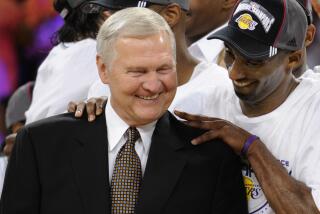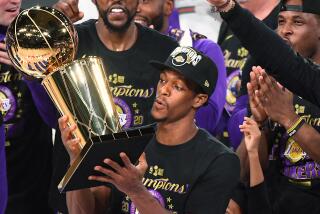Michael Jordan at 50: His competitive drive set him apart
- Share via
Michael Jordan Appreciation Week in America culminates Sunday when the best basketball player in history hits 50, which wasn’t this big a deal the first eight times Jordan saw that number next to his name as an NBA star.
Except now we are talking years, not points.
Only Dean Smith and the calendar could limit Jordan on the court, it seems, and Chicago’s enjoyable exercise in nostalgia reminded us just how rare the Air was in our city from 1984 to ’98. Every amazing Bulls highlight last week played like a song on the radio that took you back to a time worth reliving. Every memory of MJ signified a moment that transcended basketball for even casual fans who benefited from watching Jordan’s greatness.
One defining recollection from 1986, most tellingly, depicted Jordan’s unique resolve and established where his birthday celebration intersected in my mind with the other big story of the week involving a Bulls superstar.
In a fascinating 1989 documentary called “Come Fly With Me,” Jordan articulated his reasons for returning from a broken left foot to play in the final 15 games of the ‘85-86 season. Jordan missed 64 games after sustaining the serious injury Nov. 5, 1985, in the third game of his second season. He was 318 days younger than Derrick Rose was when Rose tore the ACL in his left knee April 28, and he similarly spent all winter hearing how much sense it made to sit out the entire season.
Words of caution, from Bulls Chairman Jerry Reinsdorf to others concerned about Jordan shortening his NBA shelf life, fell on deaf ears.
“Everybody told me you’re a fool for playing, go home, relax and come back next season,” Jordan said in the video. “(But) once I got that opportunity to play, I felt I had to prove to people I knew what I was doing. I wasn’t doing anything to jeopardize my career. I really felt I was healthy and I wanted to make the playoffs.”
Those were the days when the Bulls making the playoffs meant something, when progress was measured incrementally and seasons weren’t graded pass-fail based on making the NBA Finals.
Times change. We tend to glorify the past, especially in sports. But it was impossible to hear Jordan matter-of-factly expressing his desire to “make the playoffs” in 1986 and not contrast that with Rose acknowledging recently that he “won’t mind missing this year” if his knee fails to respond.
“I would love to (play this season),” Rose told reporters in Boston. “I’m trying to get back on the court as quickly as possible. But if I have anything lingering on, it’s no point.”
Rose’s comments reflect the cautious culture enveloping athletes in every sport these days more than the reluctance of a 24-year-old in whom the Bulls and Adidas have invested a combined $355 million. It’s harder than ever for superstars recovering from injuries to be like Mike and let their competitive instincts guide rehabilitation schedules. Only Rose knows how stable his knee feels — and he has been conditioned not to push his body beyond its limits the way athletes of Jordan’s era more routinely did.
Is the “110 percent” Rose seeks even realistic? Isn’t 10 months a reasonable expectation for recovery for most torn ACLs? The questions used to be easier to answer.
The trademark competitiveness Jordan showed in returning despite injury concerns nowadays comes with a steeper price. Jordan made only $630,000 in 1985-86. Today, generational wealth at stake creates an environment that compels teams, players and their inner circles to encase those bright futures in protective glass. South Carolina issued a statement Friday, for instance, announcing football star Jadeveon Clowney plans to play next fall rather than skip the season to stay healthy for the 2014 NFL draft.
Imagine such a rumor ever surrounding Jordan?
“Once I got that confidence, once the foot started getting stronger, there wasn’t anything people could have said to stop me,” Jordan said about his 1986 comeback.
It was Jordan who pushed hardest for a return the Bulls announced that March at a midnight news conference after hours of haggling among team doctors and officials. When the Bulls initially limited his minutes to seven per half, Jordan publicly criticized Reinsdorf and former general manager Jerry Krause for holding him back. Being bold then was as accepted as being wary now.
“I think people were just being conservative,” Jordan reflected after that season. “The doctors say that the bone hasn’t completely healed, but to wait for that would have meant a year, maybe a year and a half.”
Every year mattered to Jordan. All 50 have been good to basketball’s greatest competitor, whose drive was the greatest gift he ever received.
More to Read
Go beyond the scoreboard
Get the latest on L.A.'s teams in the daily Sports Report newsletter.
You may occasionally receive promotional content from the Los Angeles Times.










